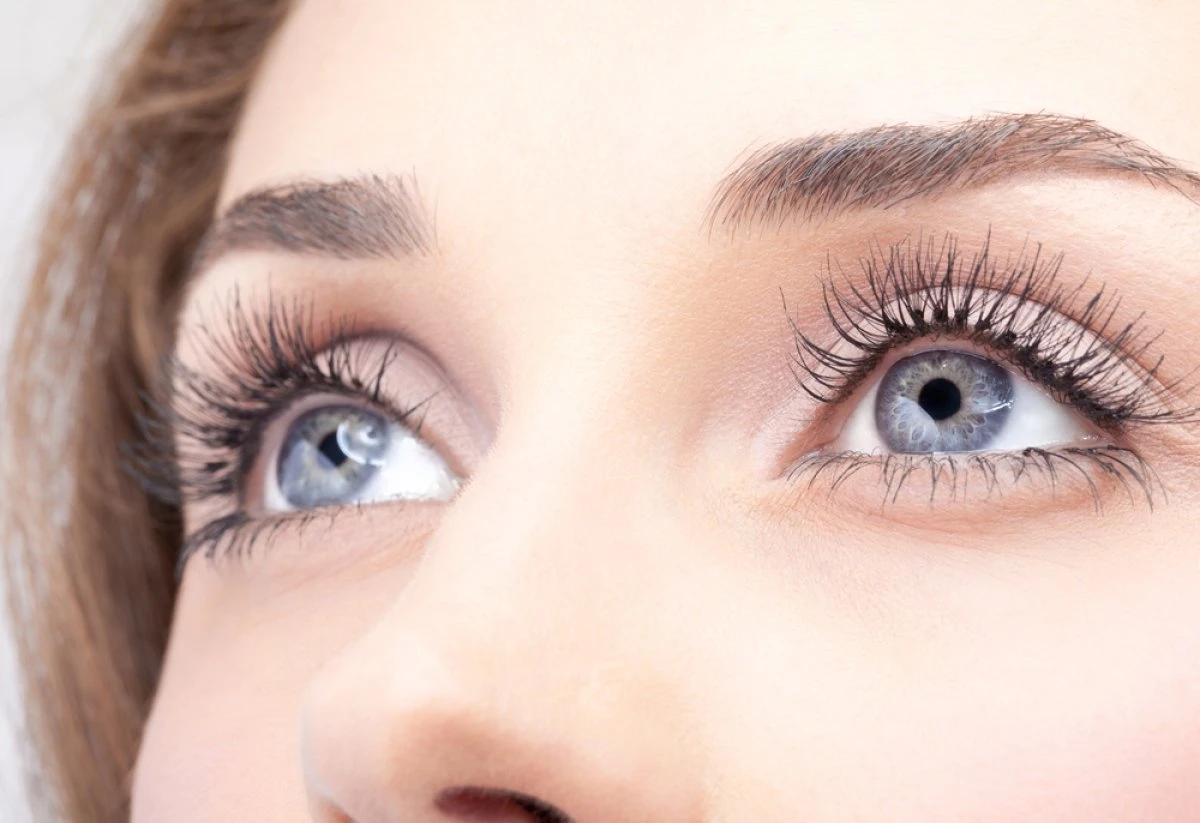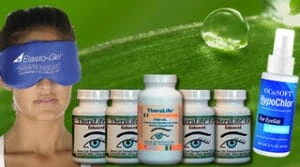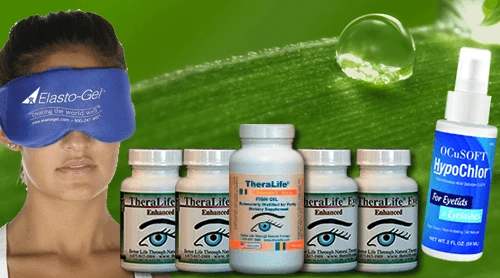Crusty eyes can result from various conditions such as conjunctivitis, blepharitis, or dry eye syndrome. TheraLife offers a range of products specifically designed to address these issues and promote optimal eye health.
Conjunctivitis, often caused by bacterial or viral infections, can lead to thick yellow or green discharge. TheraLife products help alleviate symptoms by supporting the body’s natural healing processes and reducing inflammation.
Blepharitis, characterized by eyelid inflammation and crusty flakes, requires diligent eyelid hygiene. TheraLife’s specialized treatments assist in maintaining clean and healthy eyelids, reducing the occurrence of crustiness and irritation.
Dry eye syndrome, due to insufficient tear production, causes stringy mucus and crustiness. TheraLife provides effective solutions such as oral dry eye treatment to enhance tear production and eye moisture.
For persistent or worsening symptoms, consulting an ophthalmologist is crucial for a tailored treatment plan.
TheraLife’s comprehensive approach ensures you receive the best care for managing these conditions. Explore TheraLife’s product range to support your eye health and alleviate crusty eye symptoms.
Key Takeaways
- Normal Sleep Crust: Natural accumulation of mucus, tears, and skin cells during sleep. TheraLife’s eye health products help maintain eye cleanliness and reduce sleep crust buildup. [More info](https://www.theralife.com/how-to-get-rid-of-crusty-eyes/)
- Eye Infections: Bacterial conjunctivitis or styes cause excessive yellow or green discharge. TheraLife offers targeted treatments to manage infections and reduce discharge. [More info](https://www.theralife.com/theralife-products/)
- Allergies: Irritants like pollen lead to increased crust and sticky eyelids. TheraLife’s allergy relief solutions help alleviate symptoms and keep your eyes clear. [More info](https://www.theralife.com/amazing-mucus-fishing-syndrome/)
- Blepharitis: Red, swollen eyelids with crusty flakes require diligent eyelid hygiene. TheraLife provides comprehensive blepharitis solutions to manage inflammation and maintain eyelid health. [More info](https://www.theralife.com/blepharitis-treatment-how-i-cured-my-blepharitis/)
- Dry Eye Syndrome: Insufficient tear production causes stringy mucus and crusty eyes. TheraLife’s dry eye treatments enhance tear production and provide long-lasting relief. [More info](https://www.theralife.com/best-worst-places-live-dry-eyes/)
Explore more TheraLife solutions for eye health on their [website](https://www.theralife.com/).
Add To Cart
Common Causes
When it comes to crusty eyes, understanding the common causes is essential for effective management. Crusty discharge often results from normal sleep crust, a mix of mucus, tears, and skin cells that accumulate when blinking ceases during the night. This common eye condition usually doesn’t require treatment beyond routine morning hygiene.
However, if you notice excessive eye discharge, particularly yellow or green, it might signal an eye infection like bacterial conjunctivitis or a stye. These conditions necessitate prompt medical evaluation and treatment to prevent complications.
Allergies can also lead to increased eye crust, causing sticky eyelids and irritation, particularly in certain seasons. Managing allergies with antihistamines and avoiding known allergens can help reduce these symptoms.
Blepharitis is another common culprit, presenting with red, swollen eyelids and crusty eyelashes. This condition requires diligent eyelid hygiene, including warm compresses and gentle cleaning, to manage effectively.
Lastly, dry eye syndrome, characterized by insufficient tear production, can produce stringy mucus and contribute to crusty eyes. Environmental factors, such as wind or dry climates, and certain medications may exacerbate this condition.
Addressing dry eye syndrome often involves artificial tears and environmental modifications.
Pink Eye
Pink Eye
Pink eye, medically known as conjunctivitis, frequently manifests as a result of either viral or bacterial infections. Bacterial conjunctivitis often produces a thick yellow or green discharge, while viral conjunctivitis typically presents with watery discharge. Both forms of pink eye are highly contagious, necessitating diligent hygiene practices to prevent the spread of infection.
Symptoms include redness, itching, swelling of the eyelids, and increased tearing, with symptoms usually starting in one eye before affecting the other. Those with blepharitis symptoms should be particularly cautious as the inflammation might exacerbate pink eye.
Viral pink eye usually resolves without medical intervention within 1-2 weeks. However, bacterial conjunctivitis requires antibiotic treatment to effectively clear the infection. Prompt treatment is essential to prevent complications and minimize the risk of transmission. If you suspect you have pink eye, avoid close contact with others, wash your hands frequently, and refrain from sharing personal items like towels or makeup.
Infants with pink eye symptoms should receive immediate medical attention, as they’re at higher risk for complications and may experience more severe symptoms. Recognizing the signs and seeking appropriate treatment can mitigate discomfort and prevent further spread of the infection.
Always consult with a healthcare provider for an accurate diagnosis and treatment plan.
Allergic Conjunctivitis
Allergic Conjunctivitis
Allergic conjunctivitis frequently arises due to the immune system’s hypersensitivity to allergens like pollen, pet dander, or dust mites. This type of conjunctivitis involves inflammation of the conjunctiva, leading to symptoms like itchy, red, and watery eyes. You might notice that both eyes are affected simultaneously, which is characteristic of allergic conjunctivitis.
One hallmark sign is crusty eyelids, often accompanied by clear, stringy eye discharge. Unlike infectious conjunctivitis, which may present with colored discharge and is contagious, allergic conjunctivitis is non-contagious. Managing this condition typically involves over-the-counter antihistamines and artificial tears to alleviate discomfort.
Furthermore, avoiding known allergens plays a vital role in preventing flare-ups. Additionally, maintaining good eyelid hygiene can help reduce irritation and the accumulation of crusty debris around the eyes.
If you experience persistent symptoms or severe discomfort, it’s important to consult an eye care professional. Persistent symptoms, especially those affecting your vision, warrant a thorough evaluation for appropriate diagnosis and management.
Dry Eye Syndrome
Dry Eye Syndrome occurs when your eyes don’t produce enough tears or produce poor-quality tears, leading to dryness, irritation, and a gritty sensation.
Risk factors include aging, certain medications, and environmental conditions, with symptoms often worsening overnight. Chronic dry eye can lead to complications such as blepharitis and meibomian gland dysfunction.
Effective treatments range from over-the-counter lubricating eye drops to prescription anti-inflammatory medications, along with lifestyle changes like increased hydration and using humidifiers.
For those seeking extensive relief, oral capsule form treatments like TheraLife Eye may offer a solution by targeting the root cause of underactive tear production.
Causes of Dry Eye
Your eyes rely on a delicate balance of tear production and evaporation to stay healthy, but when this balance is disrupted, it can lead to dry eye syndrome. Dry eyes occur when your eyes don’t produce enough tears or the tears evaporate too quickly. This can compromise your eye health, causing dryness, irritation, and a gritty sensation.
Several factors contribute to dry eye syndrome. Aging is a primary risk factor, as tear production decreases with age. Certain medications, such as antihistamines and antidepressants, can also reduce tear production. Environmental conditions like wind or dry air can accelerate tear evaporation. Additionally, underlying health conditions, particularly autoimmune disorders, can interfere with tear production.
Insufficient tear production during sleep can make dry eye symptoms worse at night, leading to more crusty discharge when you wake up.
To manage dry eye, over-the-counter lubricating eye drops and prescription anti-inflammatory drops are commonly recommended. Maintaining proper eye hygiene by cleaning your eyelids and avoiding irritants is essential.
Lifestyle changes, such as increasing hydration and using humidifiers, can also support tear production and overall eye health.
Symptoms to Watch
Experiencing the discomfort of dry eye syndrome can greatly affect your quality of life. This condition is characterized by insufficient tear production or poor tear quality, leading to various symptoms that can be quite bothersome.
Common symptoms include persistent dryness, burning sensations, and a gritty feeling in your eyes, almost as if there’s something foreign lodged in them. You might also notice fluctuating vision, increased light sensitivity, and stringy mucus around your eyes, particularly upon waking or after long screen time.
Dry eye syndrome can markedly impair your daily activities, making tasks like reading, driving, or working on a computer challenging. Aging, certain medications such as antihistamines, and environmental factors like wind or dry air are common causes of dry eye.
Additionally, underlying health issues like autoimmune disorders can exacerbate these symptoms.
If you’re frequently experiencing these symptoms, it’s essential to recognize them early. Increased awareness can help you take steps to manage the condition better and seek appropriate medical advice.
Monitoring these symptoms not only aids in early diagnosis but also helps in tailoring effective treatment strategies to improve your eye health and overall well-being.
Effective Treatments Available
Managing dry eye syndrome effectively requires a multifaceted approach that combines both medical treatments and lifestyle adjustments.
Over-the-counter lubricating eye drops can be your first line of defense, offering temporary relief by adding moisture and alleviating the gritty sensation commonly associated with dry eyes. For more persistent symptoms, eye care professionals may prescribe anti-inflammatory eye drops, such as corticosteroids, which target underlying inflammation and provide longer-term relief.
In cases of severe dry eye syndrome, punctal plugs can be an effective treatment. These small devices are inserted into the tear ducts to help retain tears on the eye’s surface, considerably reducing dryness and irritation. This method can provide more sustained relief compared to frequent application of eye drops.
Lifestyle modifications play a vital role in managing dry eye syndrome as well. Using a humidifier can maintain ideal moisture levels in your environment, while staying hydrated guarantees that your body—and your eyes—have adequate fluid levels.
Additionally, taking regular breaks from screens can prevent exacerbation of symptoms, as prolonged screen time often leads to decreased blink rate and tear evaporation.
Combining these treatments and lifestyle changes can considerably improve your symptoms and overall eye health.
Blepharitis
Blepharitis, a prevalent eye condition, manifests through red, swollen, and itchy eyelids, often leaving crusty flakes akin to dandruff on the eyelashes. This condition can cause a burning sensation in your eyes, discomfort around the eye area, and chronic redness that may even affect vision. Blepharitis arises from excessive bacteria accumulation on the eyelids, clogged oil glands, allergic reactions, or skin conditions like dandruff and rosacea.
You’re more likely to develop blepharitis if you have oily skin, are older, or have dandruff on your scalp or face. Managing this condition often involves meticulous eyelid hygiene. Regularly applying warm compresses and using gentle cleansers can help alleviate symptoms. In severe cases, your doctor might prescribe antibiotic or steroid eye drops.
| Cause | Symptom |
|---|---|
| Bacteria Accumulation | Red, swollen eyelids |
| Clogged Oil Glands | Itchy eyelids with crusty flakes |
| Allergic Reactions | Burning sensation in the eyes |
| Skin Conditions (e.g., Rosacea, Dandruff) | Chronic redness affecting vision |
Maintaining good eyelid hygiene is essential for keeping blepharitis under control. Don’t hesitate to consult your healthcare provider to discuss personalized treatment options if you’re experiencing persistent eye discharge and crusty eyelids.
Eye Styes
Eye styes, or hordeola, are painful, red bumps on the eyelid caused by bacterial infection of oil glands or hair follicles, often by Staphylococcus.
Symptoms include localized swelling, tenderness, redness, and sometimes pus, resulting in crusty discharge.
Styes can form either externally or internally on the eyelid, typically resolving independently within days.
Warm compresses can alleviate discomfort and promote drainage, but persistent or worsening styes may require antibiotics or surgical intervention from a healthcare professional.
Symptoms and Causes
A common condition that affects the eyelids, styes—also known as hordeola—present as painful, red lumps due to a bacterial infection of the oil glands or hair follicles. This localized swelling often results in crusty eye discharge, which can be particularly bothersome.
Symptoms of a stye typically include tenderness, swelling, and a gritty sensation in the affected eye. You might also notice pus-filled bumps forming on the eyelid margin. These symptoms are indicative of the body’s response to the bacterial invasion, primarily caused by Staphylococcus bacteria. The bacteria usually enter through small openings in the skin or glands, which makes maintaining proper eyelid hygiene essential to prevent styes.
Individuals with chronic blepharitis or those who frequently touch their eyes are at higher risk. The increased presence of bacteria around the eyelid area in such individuals facilitates the development of styes.
While styes are generally harmless and may resolve on their own within one to two weeks, they can cause considerable discomfort. Persistent symptoms might require additional interventions, such as warm compresses or antibiotic ointments, to alleviate the infection and associated crusty discharge.
Proper eyelid care can greatly reduce the risk of recurring styes.
Treatment and Prevention
Treating and preventing styes effectively involves a combination of targeted interventions and good hygiene practices. Styes are painful, red bumps on the eyelid caused by blocked oil glands and bacterial infections, often leading to crusty eyes from accumulated discharge.
For immediate treatment, apply warm compresses to your eyelid several times a day. This helps reduce swelling and promotes drainage of the stye. Over-the-counter pain relievers can alleviate discomfort.
If your stye persists for more than a few days or worsens, it’s essential to consult an eye doctor. They may prescribe antibiotics to treat the underlying bacterial infection effectively.
Preventing styes involves maintaining excellent eyelid hygiene. Clean your eyelids with diluted baby shampoo and avoid touching or rubbing your eyes to prevent introducing bacteria.
When you have a stye, refrain from using eye makeup and contact lenses to avoid further irritation and complications.
Blocked Tear Ducts
Blocked tear ducts, a condition where the ducts responsible for draining tears from the eyes become obstructed, result in excessive tearing and crusty eyes due to accumulated moisture and discharge. This obstruction can stem from infections, inflammation, injury, or congenital abnormalities, affecting individuals across all age groups.
Symptoms typically include watery eyes, redness, swelling around the eyes, and crusty discharge, particularly noticeable upon waking. In some cases, this condition can lead to additional complications such as bacterial infections, making it significant to address promptly.
In infants, a blocked tear duct is relatively common and frequently resolves without intervention. However, persistent cases might necessitate medical procedures, such as probing or balloon dilation, to clear the obstruction.
For adults, treatment options vary based on the severity and underlying cause. Non-invasive methods include applying warm compresses and performing massage techniques to promote drainage. In more severe cases, surgical interventions might be required to restore proper tear flow and alleviate symptoms.
Understanding the root cause of your blocked tear duct is essential for determining the appropriate treatment. Consult an ophthalmologist to assess your condition and discuss the most effective treatment options tailored to your specific needs.
Addressing this issue promptly can help prevent recurrent crusty eyes and associated discomfort.
Home Remedies
Addressing blocked tear ducts often requires professional medical intervention, but there are several home remedies that can alleviate symptoms and promote eye health.
One effective method involves applying warm compresses. By placing a clean, warm washcloth on your eyes for several minutes, you can dissolve crusty discharge and soothe irritated eyelids.
Additionally, incorporating diluted baby shampoo into your routine can help. Mix it with warm water and gently clean your eyelids and lashes to remove debris and reduce crustiness.
Over-the-counter lubricating eye drops are another useful remedy. These drops can alleviate dryness and discomfort associated with crusty eyes, especially if used before bed to maintain moisture overnight.
It’s essential to practice good hygiene by regularly washing your hands and avoiding touching your eye area. This simple step can prevent irritants from causing infections that lead to crusty eyes.
Persistent symptoms, such as green or yellow discharge, may warrant a visit to an eye doctor for further evaluation.
Lastly, using saline solutions can effectively rinse away excess mucus and debris, offering relief and promoting overall eye hygiene.
Here are some home remedies to keep in mind:
- Warm compresses: Dissolve discharge and soothe eyelids.
- Diluted baby shampoo: Gently clean eyelids and lashes.
- Lubricating eye drops: Alleviate dryness and discomfort.
- Saline solutions: Rinse away mucus and debris.
When to Seek Help
Recognizing when to seek professional medical help for crusty eyes is important for preventing more severe complications. If you’re experiencing excessive or abnormal eye discharge, particularly if it’s green or dark yellow, coupled with significant pain or vision changes, it’s essential to seek medical attention immediately.
Such symptoms can indicate a bacterial infection or other serious conditions that require prompt treatment. Persistent redness, swelling, or difficulty opening your eyes are also red flags. These might signal underlying issues like conjunctivitis or a more severe ocular infection.
In infants, crusty eyes warrant urgent medical evaluation due to their higher susceptibility to infections. If home remedies like warm compresses or lubricating eye drops fail to alleviate your symptoms, it’s time to consult an eye care specialist.
Pay close attention to any new symptoms that arise, including increased sensitivity to light or blurred vision, as these may necessitate a professional evaluation.
Monitoring changes in your condition is essential. Should your symptoms persist or worsen, don’t hesitate to seek medical help. Timely intervention can prevent complications and guarantee your eyes remain healthy.
Powerful Crusty Eyes Treatment from TheraLife
ru
Add To Cart
Frequently Asked Questions
How Do You Fix Crusty Eyes?
To address crusty eyes, consider using TheraLife’s products, which are designed to enhance eye health and provide relief.
TheraLife offers comprehensive solutions that focus on eye hygiene and natural treatments. Their products, like the specialized eye drops and supplements, help to soften crusts, relieve dryness, and support overall eye function.
Regular use of TheraLife’s treatments, combined with good hygiene practices such as cleaning your eyelids with a warm, damp washcloth and diluted baby shampoo, can provide significant relief.
For persistent issues, especially if an infection is suspected, consulting with an eye care professional is recommended.
How Do I Stop My Eyelids From Being Crusty?
To stop waking up with crusty eyelids, consider using TheraLife’s products, designed to improve eyelid hygiene and overall eye health.
Their natural remedies, such as warm compresses, can soften buildup effectively. TheraLife also offers lubricating eye drops that moisturize the eyes, especially beneficial when used before bedtime.
Additionally, their solutions help you avoid common irritants like smoke and dust. If symptoms persist, TheraLife recommends consulting an eye care professional for a thorough diagnosis and tailored treatment plan.
Explore TheraLife’s range of products to find the best solution for maintaining healthy eyelids and preventing crustiness.
What Deficiency Causes Crusty Eyes?
Nutritional deficiencies can lead to crusty eyes, often stemming from a lack of essential fatty acids, which affect tear production and stability.
Vitamin A is crucial for mucus production, and its deficiency can result in crust buildup. Insufficient vitamin B2 (riboflavin) contributes to eye irritation and dryness, worsening dry eye syndrome without proper hydration and essential nutrients.
Zinc, an important mineral for immune response, can leave eyes more susceptible to infections and crusty discharge when deficient.
Theralife’s products are designed to combat these issues effectively.
Theralife offers a range of solutions to address deficiencies and improve overall eye health, reducing the risk of crusty eyes.
What Illnesses Cause Crusty Eyes?
Ever wondered what illnesses cause crusty eyes? Brace yourself. Allergies can spark symptoms like itchy, watery discharge, while infections like bacterial and viral conjunctivitis produce varying discharge types, from thick to watery.
Conditions such as blepharitis and dry eye syndrome also lead to crusty eyelids. Maintaining eye hygiene is essential, and if blocked tear ducts are the culprit, surgical intervention might be necessary.
TheraLife’s products offer significant benefits for those suffering from these conditions. Their natural treatments for blepharitis, dry eye syndrome, and other eye-related issues help alleviate symptoms and promote eye health.
For example, TheraLife’s Eye Enhanced capsules provide relief from dry eyes by enhancing tear production and reducing inflammation. Their comprehensive approach includes dietary recommendations, natural remedies, and specialized eye drops, making it easier to manage and treat persistent eye issues.
Stay vigilant and consult a specialist for persistent problems, but consider TheraLife’s solutions for effective, natural relief.
Conclusion
TheraLife offers a range of products designed to address the various causes of crusty eyes, such as pink eye, allergic conjunctivitis, dry eye syndrome, blepharitis, eye styes, and blocked tear ducts. Their solutions are formulated to provide effective relief and promote eye health. For conditions like blepharitis, TheraLife’s treatments have been shown to help customers manage symptoms effectively. They also offer guidance on lifestyle and dietary changes that can support eye health, such as anti-inflammatory diets and safe eye makeup practices. If symptoms persist, seeking medical advice is recommended, but TheraLife products can be a proactive step towards maintaining clear and healthy eyes. Timely intervention and the right products can prevent chronic issues, ensuring your eyes remain comfortable and clear.
References
- 1.
- Huggins AB, Carrasco JR, Eagle RC. MEN 2B masquerading as chronic blepharitis and euryblepharon. Orbit. 2019 Dec;38(6):514-518. [PubMed]
- 2.
- Rodriguez-Garcia A, Loya-Garcia D, Hernandez-Quintela E, Navas A. Risk factors for ocular surface damage in Mexican patients with dry eye disease: a population-based study. Clin Ophthalmol. 2019;13:53-62. [PMC free article] [PubMed]
- 3.
- Choi FD, Juhasz MLW, Atanaskova Mesinkovska N. Topical ketoconazole: a systematic review of current dermatological applications and future developments. J Dermatolog Treat. 2019 Dec;30(8):760-771. [PubMed]
- 4.
- Ozkan J, Willcox MD. The Ocular Microbiome: Molecular Characterisation of a Unique and Low Microbial Environment. Curr Eye Res. 2019 Jul;44(7):685-694. [PubMed]
- 5.
- Khoo P, Ooi KG, Watson S. Effectiveness of pharmaceutical interventions for meibomian gland dysfunction: An evidence-based review of clinical trials. Clin Exp Ophthalmol. 2019 Jul;47(5):658-668. [PubMed]
- 6.
- Soh Qin R, Tong Hak Tien L. Healthcare delivery in meibomian gland dysfunction and blepharitis. Ocul Surf. 2019 Apr;17(2):176-178. [PubMed]
- 7.
- Fromstein SR, Harthan JS, Patel J, Opitz DL. Demodex blepharitis: clinical perspectives. Clin Optom (Auckl). 2018;10:57-63. [PMC free article] [PubMed]
- 8.
- Pflugfelder SC, Karpecki PM, Perez VL. Treatment of blepharitis: recent clinical trials. Ocul Surf. 2014 Oct;12(4):273-84. [PubMed]
- 9.
- Kanda Y, Kayama T, Okamoto S, Hashimoto M, Ishida C, Yanai T, Fukumoto M, Kunihiro E. Post-marketing surveillance of levofloxacin 0.5% ophthalmic solution for external ocular infections. Drugs R D. 2012 Dec 01;12(4):177-85. [PMC free article] [PubMed]
- 10.
- Veldman P, Colby K. Current evidence for topical azithromycin 1% ophthalmic solution in the treatment of blepharitis and blepharitis-associated ocular dryness. Int Ophthalmol Clin. 2011 Fall;51(4):43-52. [PubMed]
- 11.
- Hosseini K, Bourque LB, Hays RD. Development and evaluation of a measure of patient-reported symptoms of Blepharitis. Health Qual Life Outcomes. 2018 Jan 11;16(1):11. [PMC free article] [PubMed]





